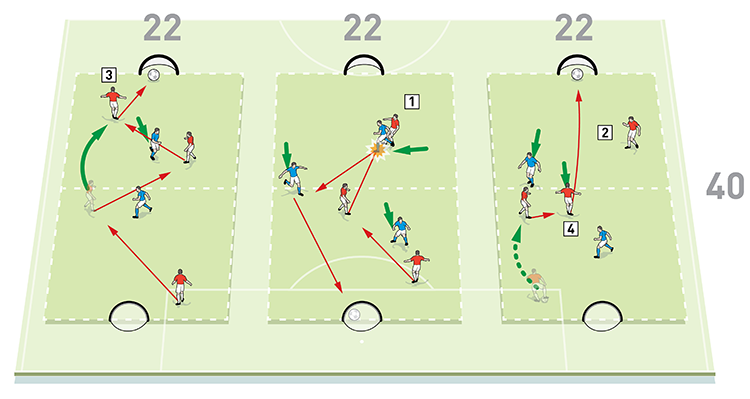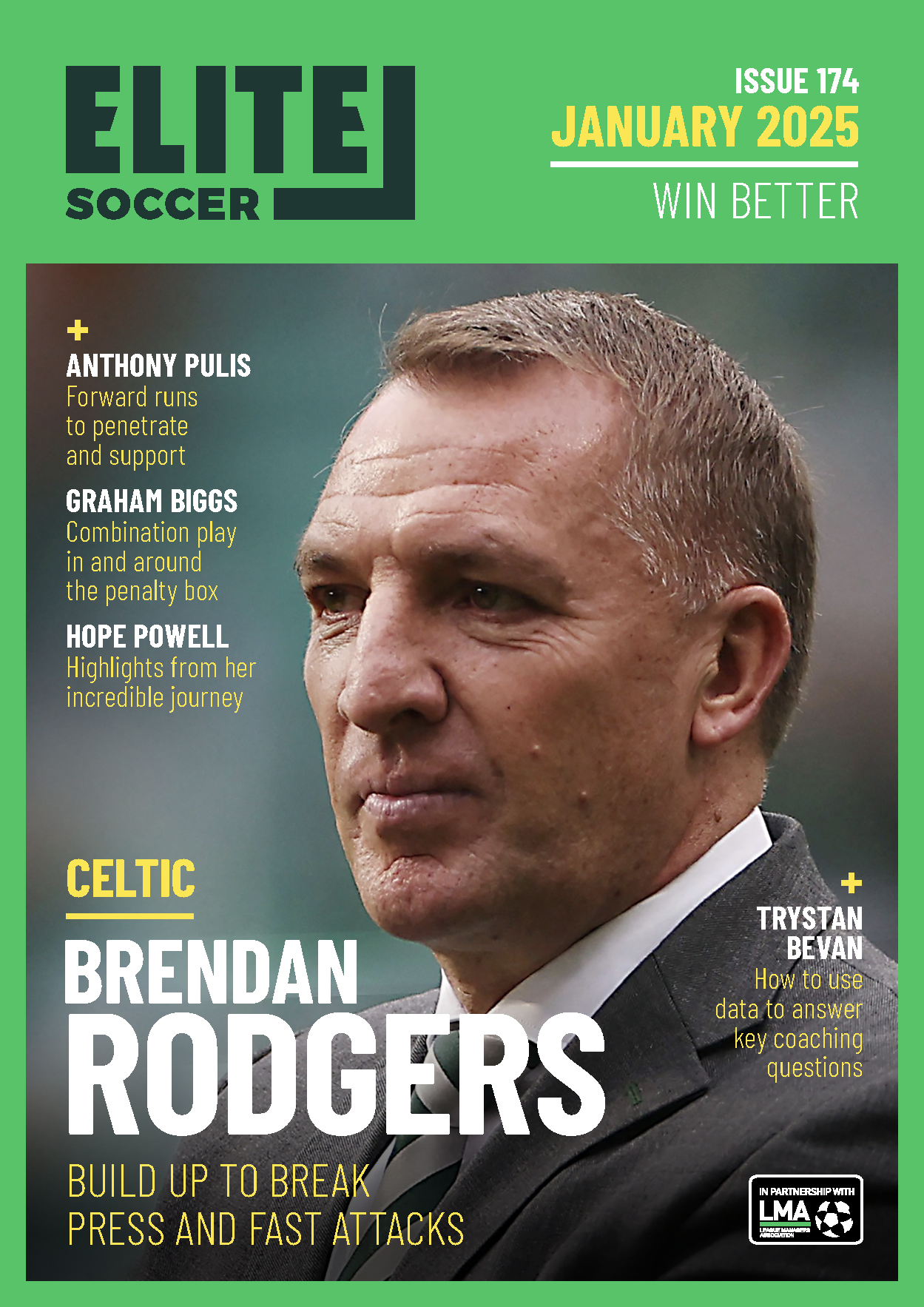You are viewing 1 of your 1 free articles
Building an attack
| Area | Two thirds of pitch |
| Equipment | Balls, bibs, cones, 6 target goals, 3 small goals, 2 full size goals |
| No. of Players | Up to 16 players+2 goalkeepers |
| Session Time | Mini games: 15mins, Phase of play: 30mins, Gameplay: 45mins |
This session focuses on the principles of initiating and building an attack in order to play forward and enter the opposition half when playing against full opponent pressure.
The practice is designed to create an environment where players can make decisions on time and space and solve their own problems. This activity can be run every week with different challenges and a manipulation of the constraints, based on the individual needs of the players. It is very much a game-related session.
What do I get the players to do?
Mini games
We start by warming players up with an arrival activity. We set up three adjacent playing areas of approximately 40x22 yards each, with a target goal at each end of all three areas. We’re using 16 outfield players split into nine reds and seven blues. We run a directional game on each of the three playing areas, with a 3v3 on the central pitch and a 3v2 on each of the outside pitches, as shown [1]. The games should be played simultaneously.
1

2. Play 3v2 on each of the outside pitches
3. The first goal in each game can only be scored from inside the opposition half
4. From the second goal onwards, teams can score from anywhere on the pitch
There are no throw ins (play restarts either with a kick in or by dribbling in from the touchline). To score, players must use a one-touch finish into the mini goal that they are attacking. The first goal can only be scored from inside the opposition half but thereafter goals can be scored from anywhere on the pitch.
We would play four games of three minutes each, with one minute’s break between games to coach.
How do I progress the activity?
We progress the activity so that once a player has scored on one pitch, he must run to another pitch, which would have the result of changing the overload dynamic on both the pitch he leaves and on the pitch he joins.
We can progress the activity further by limiting play to a single ball between three pitches and freeing the players so they are no longer locked into their areas, resulting in a free-play 9v7 with players focusing on building up to go forward.
What are the key things to look out for?
We want to see players capable of demonstrating how a pass or a dribble can eliminate an opposition defender from the game in order to go forwards. Players should also show they understand how to create space for themselves or for their team mates.
What do I get the players to do next?
Phase of play
We set up on just over half a pitch, with a full size goal at one end and three mini goals at the other end. We mark out five zones down the length of the pitch, as shown [2]. We’re using 15 outfield players and a goalkeeper, split into two teams of eight. The team of seven outfield players and a keeper (the reds) defends the full size goal and it lines up in a 1-3-3-1 formation, while the other team (the blues) defends the three mini goals and it lines up in a 2-4-2 system of play with a diamond in the midfield.
2

2. The blue team of eight outfield players defends the three mini goals and line up in a 2-4-2 formation with a diamond in the midfield
3. When in possession, the reds must try to occupy all five of zones and they must score in one of the three mini goals with a one-touch finish
4. If the blues win the ball, they must try to score in the main goal and the reds should defend centrally to stop them
The two teams play an 8v8 game – it’s free play and the players are not locked into the zones, which are simply used as a visual reference. However, the red team attacking the three mini goals must try to occupy all five zones when in possession and they must score with a one-touch finish. When out of possession, they must try to protect the centre of the pitch and should defend in the three middle zones. If the ball goes into the outside channels, they should move to defend in four of the five zones.
We look for the blues to try to set traps and prevent build-up play from the reds. Upon regaining the ball, the blues should try to score in the main goal. Every time the blues score, deduct one goal from the reds’ tally.
Normal rules apply for things such as throw-ins. We play three games of eight minutes, with two minutes of rest between games.
How would you put this into a game situation?
Game play
We set up on two thirds of a pitch with a goal and a goalkeeper at each end. We’re using 14 outfield players split into two teams. We play a normal 8v8 game including keepers, with the reds set-up in a 1-3-3-1 formation and the blues in a 1-1-4-2 system, as shown [3].
3

2. The blues are set-up in a 1-1-4-2 formation
3. The reds should look to score as soon as they enter the opposition half
We coach the opposition team first by creating a ‘counter-principle’ in order to make the attacking focus more challenging. We observe the blues and if using two coaches, the blues can be set-up by an ‘opposition coach’ to create traps for the attacking team.
The reds should try to score as soon as they enter the opposition half and the blues should counter-attack if they win possession of the ball.
We try to bring into play the kind of movements learned by the players in the first two activities. We try to show the players how and when to play around, play back or play through. We also show them how to run to receive and when to run to deceive.
Normal rules apply. We play a game of 40 minutes with a four-minute break at halftime, when players are encouraged to ask questions of the coaches and of each other.
What are the typical mistakes players might make and how do I avoid them?
Players may find it difficult to create third and fourth line entries or they may receive on the same horizontal or vertical receiving lines, which means their movements will cancel each other out.
Related Files
Editor's Picks
Using the goalkeeper in build-up play
Pressing principles
Intensive boxes drill with goals
Penetrating the final third
Creating and finishing
My philosophy
Pressing initiation
Compact team movement
Defensive organisation
Coaches' Testimonials

Alan Pardew

Arsène Wenger

Brendan Rodgers

Carlos Carvalhal

José Mourinho

Jürgen Klopp

Pep Guardiola

Roy Hodgson

Sir Alex Ferguson

Steven Gerrard
Coaches' Testimonials

Gerald Kearney, Downtown Las Vegas Soccer Club

Paul Butler, Florida, USA

Rick Shields, Springboro, USA

Tony Green, Pierrefonds Titans, Quebec, Canada
Join the world's leading coaches and managers and discover for yourself one of the best kept secrets in coaching. No other training tool on the planet is written or read by the calibre of names you’ll find in Elite Soccer.
In a recent survey 92% of subscribers said Elite Soccer makes them more confident, 89% said it makes them a more effective coach and 91% said it makes them more inspired.
Get Monthly Inspiration
All the latest techniques and approaches
Since 2010 Elite Soccer has given subscribers exclusive insight into the training ground practices of the world’s best coaches. Published in partnership with the League Managers Association we have unparalleled access to the leading lights in the English leagues, as well as a host of international managers.
Elite Soccer exclusively features sessions written by the coaches themselves. There are no observed sessions and no sessions “in the style of”, just first-hand advice delivered direct to you from the coach.









